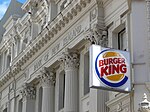Ngā Taonga Sound & Vision
2012 mergers and acquisitions2014 establishments in New Zealand2014 mergers and acquisitionsFIAF-affiliated institutionsFilm archives in New Zealand ... and 4 more
Film organisations in New ZealandHistory of radioSound archivesTelevision archives

Ngā Taonga Sound & Vision (Operating name for The New Zealand Archive of Film, Television and Sound Ngā Taonga Whitiāhua Me Ngā Taonga Kōrero.) is an archive that was launched on 31 July 2014, following the completion of a three-year process whereby the New Zealand Film Archive "absorbed" the collections and operations of the RNZ Sound Archives Ngā Taonga Kōrero in 2012 and the Television New Zealand Archive in 2014.
Excerpt from the Wikipedia article Ngā Taonga Sound & Vision (License: CC BY-SA 3.0, Authors, Images).Ngā Taonga Sound & Vision
Taranaki Street, Wellington Te Aro
Geographical coordinates (GPS) Address Nearby Places Show on map
Geographical coordinates (GPS)
| Latitude | Longitude |
|---|---|
| N -41.293656 ° | E 174.777939 ° |
Address
Taranaki Street 84
6011 Wellington, Te Aro
Wellington, New Zealand
Open on Google Maps







